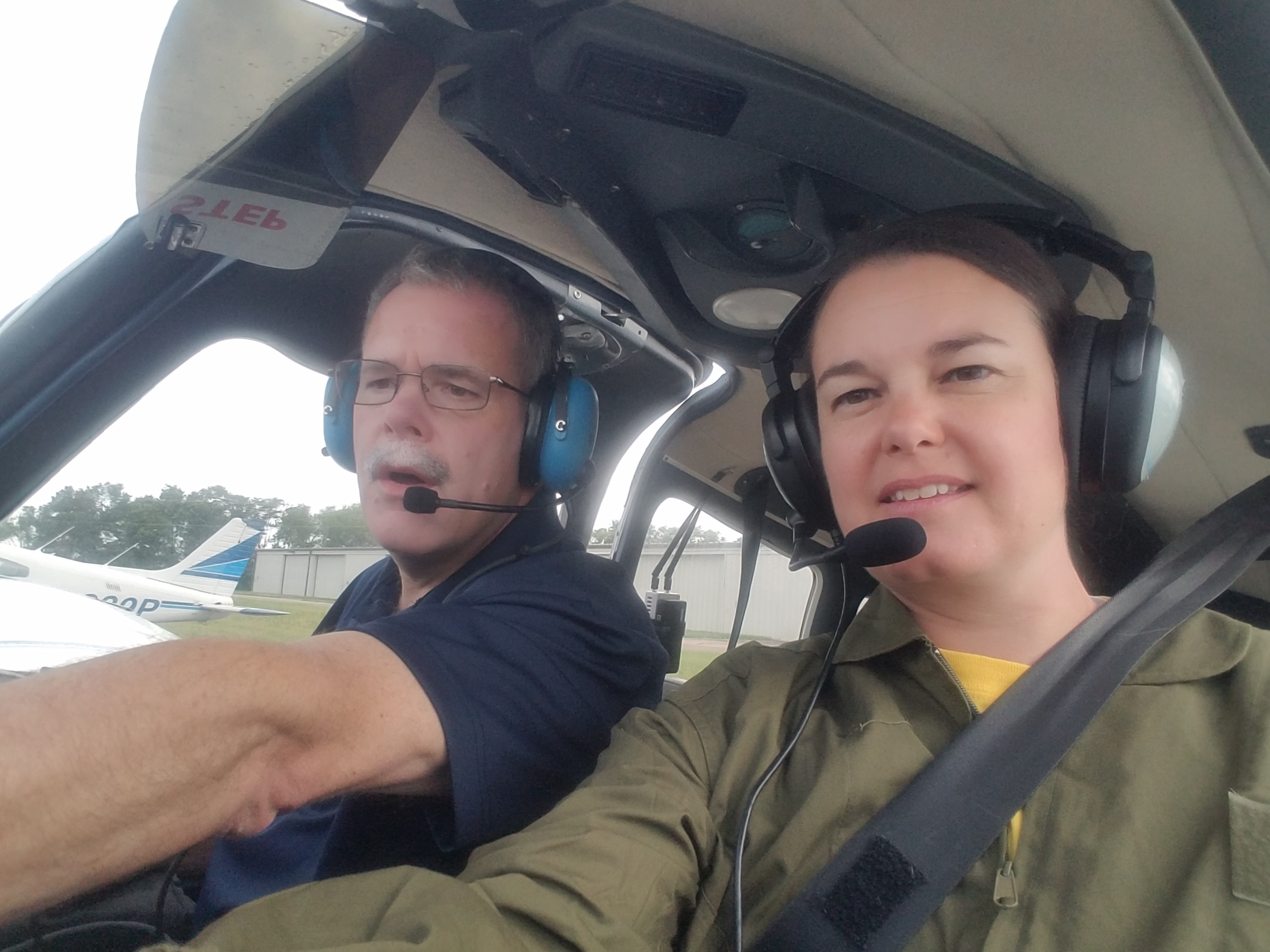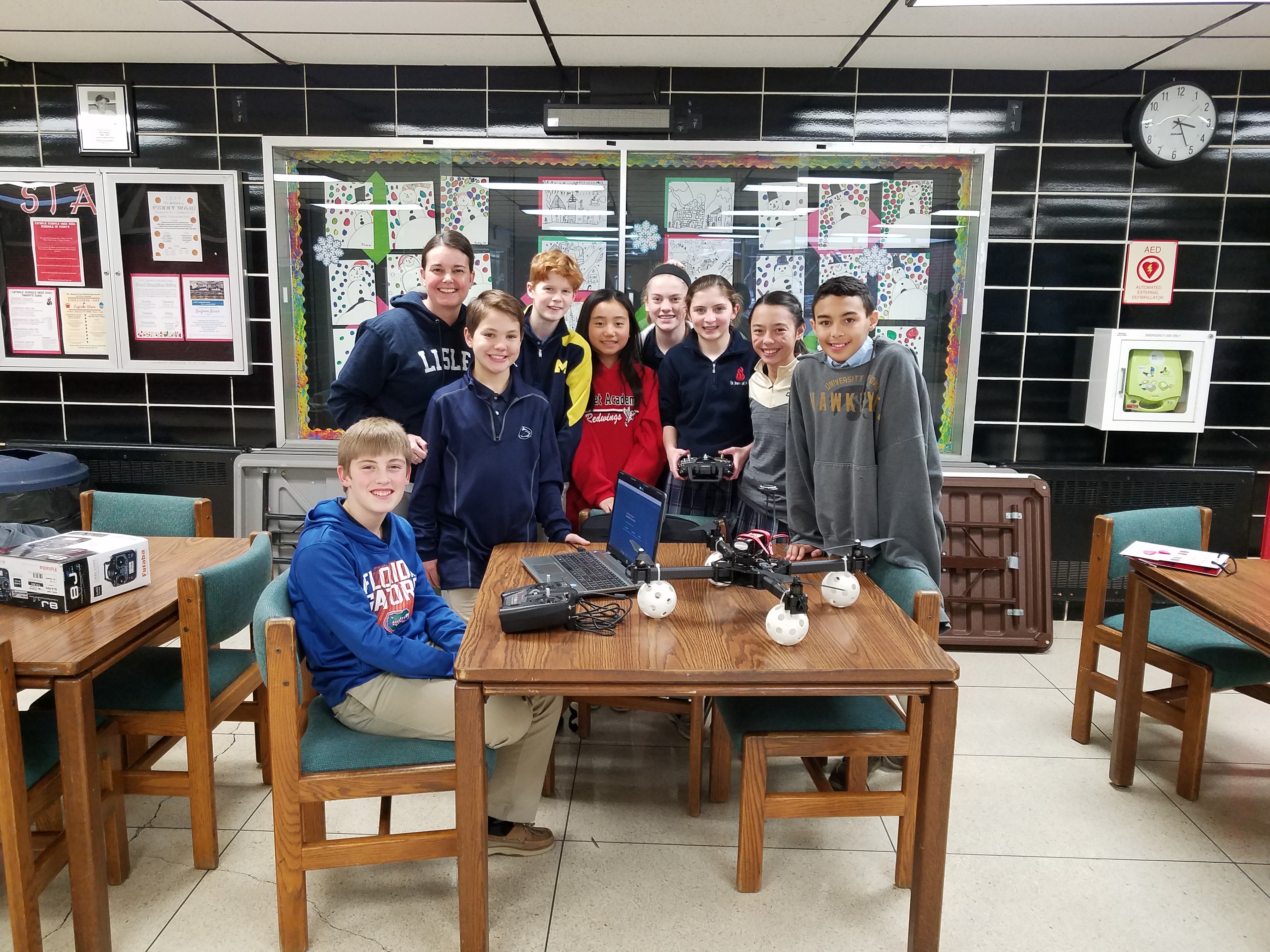Illinois AEM Tanya Anderson credits CAP materials for sparking curiosity about STEM among students
Posted on May 19, 2020 at 3:00 PM by Virginia Smith
 |
| AEM Tanya Anderson learns to fly at National Teachers Air Camp in Dayton, Ohio, in 2019. |
May 19, 2020
Meet Tanya Anderson, a junior high science teacher from Lisle, Illinois. She is passionate about aerospace/STEM topics and says students respond well to that enthusiasm. Anderson, a former Civil Air Patrol Teacher of the Year, loves introducing her students to new educational experiences, such as the ready-to-fly drone or robotic arm she received from the CAP STEM Kit program. "I am hoping something we do in class sparks a curiosity that will cause them to take additional classes in high school or college that could lead to a new area of study, an additional career option or even just a hobby." We asked her some questions about teaching and being involved with CAP. Her answers are below.
Tell us about the school at which you work and the grades that you teach.
I teach at St. Joan of Arc School in Lisle, Illinois. I teach junior high science to all of the school’s sixth-, seventh- and eighth-grade students.
How many years have you been an educator?
I have been teaching for 14 years. The last 11 years have been in my current position.
 |
| Tanya Anderson at the 2017 NASA Microgravity University for Educators. |
Please list any awards/honors you have received as an educator.
- 2013 NASA’s Teaching from Space Microgravity Education Program participant
- 2014 Civil Air Patrol Great Lakes Region Aerospace Education Teacher of the Year
- 2015 Civil Air Patrol National Aerospace Education Teacher of the Year
- 2017 NASA’s Microgravity University for Educators Program participant
- 2019 National Teachers Air Camp participant
How many years have you been involved in Civil Air Patrol?
I have been involved in the Civil Air Patrol since 2010
How did you become involved with CAP?
I first heard about the Civil Air Patrol from another educator, who mentioned the different programs, and I decided to check it out.
Which Civil Air Patrol programs do you and your students use? What benefits do your students get from these programs.
I participate in CAP’s AEX, ACE, and STEM Kit programs. Each of these programs provides different experiences to incorporate into my classroom. I use the AEX program with my eighth graders who study physics. We use different activities in this program to demonstrate and explore different physics concepts like the laws of motion and fluid forces. The students study different factors that affect flight and enjoy experimenting with different types of rockets. The ACE program is part of my sixth-grade curriculum. In sixth grade we focus on Earth and space science, and so many of the activities pair well with the concepts we are discussing in class. I use the character lessons in the ACE program to help reinforce teamwork and proper lab group collaboration. The STEM kits are used throughout my curriculum to enhance hands-on learning in many different areas.
Why do you teach in the aerospace education/STEM field?
I teach in the aerospace education/STEM area because I enjoy it, and I think it is fun. Students can tell when you enjoy and are passionate about what you are teaching them. I like opening their minds to new areas of study and allowing them to have new experiences. Whether it is using a 3D printer for the first time, flying a drone, or using a robotic arm, I am hoping something we do in class sparks a curiosity that will cause them to take additional classes in high school or college that could lead to a new area of study, an additional career option or even just a hobby.
What do you like about using CAP programs and materials?
I like the CAP programs because they are easy to use, and they allow me to add variety to my curriculum.
How have the current stay-at-home restrictions affected how you teach your students?
The current stay-at-home restrictions have really been challenging. Trying to find activities that students can do at home without knowing what resources they have access to is not easy. Thankfully, at the beginning of this school year, our school had rolled out the use of Google Classroom, which had prompted me to become a Level 1 Certified Google Educator last summer. (Funny how things work.) So my students had been familiar with using Google Classroom, which helped and has become the main way of posting assignments and daily announcements. I have been using Zoom to check-in in person with each of my classes once a week and as a way of giving struggling students one on one or small group support. Honestly, the Zoom calls have been the best part. I love being able to see the students and have real conversations with them. I have also quickly learned how to record class lectures/notes using Screencastify. This allows students to watch and re-watch a lesson on their own schedule.
As far as trying to re-create hands-on activities, I am trying to do as much as I can with videos and online simulations. My seventh-grade students will be doing a virtual frog dissection next week using a couple of different tools that I have found online, and all of the junior high students will be taking a virtual field trip using a wonderful National Geographic website. The thing about teaching virtually is you have to find resources and then learn on the fly how to use them. You also need to try to become an expert on different resources as quickly as possible so not only can you share them with your students but also be able to troubleshoot their problems. On top of this, you are trying to create daily assignments, give feedback on assignments and work, and support the technology. It can get very overwhelming at times. This has definitely made me realize and appreciate the fact that I became a teacher to interact with the students in person and not spend eight hours a day in front of a computer.
Now, after more than two and a half months of remote learning, we have all been doing our best to finish the school year and continue with our curriculum as much as possible. I truly feel my students have been awesome at adapting to our new reality and have been doing a great job in a difficult situation. I hope and pray every day that I will get to see my students in school again in the fall.
Do you have any advice for a new AEM working with CAP programs and materials?
The best advice I have for a new AEM is don’t be afraid to try something new. The best part of the different CAP programs is that you do not need to be an expert at teaching aerospace, robotics or STEM to use the resources with your students.
Please tell an anecdote of a rewarding experience working with students using CAP programs and materials?
I have had lots of rewarding experiences that have stemmed from using CAP’s programs. This year my seventh graders had a UAS team competing in the UAS4STEM program that was the result of a flyer provided by CAP in a drone STEM kit that I received last spring. Additionally during the last nine years I have been able to develop and evolve a few simple robotics lessons into a semester-long robotics curriculum for my students. This was a result of receiving a few robotic arm STEM kits back in 2011. This current curriculum not only includes the robotic arms but also the Sphero robots, and mini drones all of which are available as STEM kits. This year as a result of the Bee-Bot STEM kits, I have also been able to expand the use of robotics at our school to our elementary students as well. I love to see what new resources and opportunities being an AEM in the Civil Air Patrol will bring next.
 |
| Tanya Anderson leads the seventh-grade UAS team at St. Joan of Arc School. |



